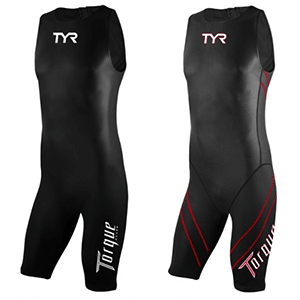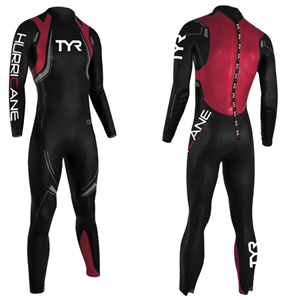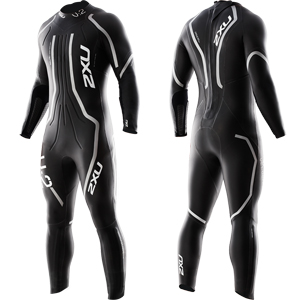TYR Torque 2012

Swimming’s world governing body, FINA, officially ended the Suit Wars era and stopped the arms race as regards swim skin technology. In fact, FINA rolled technology back to the 90's: jammers for men, and the typical one piece for women. All that has changed is the materials. Unable to provide any flotation now, advanced hydrodynamic properties are what’s left to tinker with.
But in triathlon we are allowed to wear some of these old speed suits, often referred to swim skins. Mimicking the traditional trisuit in pattern and design, they are a cut above when it comes to being slippery in the water. Below is my first trial in these swim skins. You might find it interesting; I certainly did.
I have finally come to understand many of the claims I often thought suspect and that, at base, were driven by monetary gain. Starting at the turn of the century we began to see more and more material showing up on world class swimmers. The most obvious was the full body suit used by Ian Thorpe in the Olympics. Originally the suits were standard textiles covering more of the body. There were waist-to-ankle, tri-suit style, and full-body. The tri-suit style seemed to win out, made faster by annual advances in materials. At the height of the wars, some swimmers were abandoning the suits provided by their sponsors in favor of a competitor’s suit, all because of a real or perceived advantage.
Records were falling meet after meet, set by folks who, in some cases, were not known for making the podium. Michael Phelps had just won 8 gold medals, setting new world records, yet was getting beat by seconds in the 200 free. We watched what we thought would be a decade long record erased virtually overnight. It was laughable, and before the ink dried a new world record would be set.
In the age group and kids ranks parents began to complain about the $500 and upwards prices of these suits, and the frequency that they had to be upgraded. Little Johnny who had been winning all season was now banana heat fodder without the latest in tech suits. Looking back, I think this pressure from the parents did more than anything to stop this hyper progression in the suit wars.
At the end, suits were coated with rubber and began to look very similar to the wetsuits we wore as triathletes, just a lot thinner. They were hyper tight, as compression was now a factor in the speed of the suits. My best guess about this period, it looks like world class swimmers got between 1 to 2 seconds per 100 meters form the suits. Some folks benefited at the high end of the scale, while others the low. Now if you go and look at the finals of any big meet, often the final 8 guys in the sprints will all come in within a second, so you can see how being one of the lucky high range swimmers really paid off. Paul Biedermann was one of those swimmers, and still holds the WR in the 200 meter free at 1:42.00, almost a full second faster than a suited Phelps.
Against this history, I been quite skeptical about the claims some athletes and swim skin companies have been making. Some writing on the Slowtwitch reader forum claimed 5 to 20 second range per 100. I have always eschewed the use of these suits in my own swimming and therefore had no firsthand experience. So, for the past couple years, I have been quite skeptical of these time gains by triathletes, especially knowing what the world class swimmers were getting out of them. Since they do not float like wetsuits do, it just did not seem possible that anyone would get anywhere near the wetsuit advantage.
I decided to finally see for myself what all the fuss was about. My first tests were on the TYR Torque Elite and the TYR Torque PRO. The specs and materials of these two suits can be found at that link. My first test was on a new Elite, the cheaper of the two, it was in a 25 yard pool at 81 degrees. The control suit was a TYR jammer in used condition.
After doing a 3×100 warm-up on the 1:30 short course yards, I went straight into 10×100 @ 1:30 with the Elite. I decided I would go at about Ironman pace so that i could be comfortable and do a lot of 100's. That 1st set went like this:
1:17/17/17/17/17/17/18/17/17/17.
I was using a digital clock with no tenths, so send off was probably within .2 seconds, and finish times are +/- .8 seconds. With the number of 100's I was doing, I figure it all evened out in the end, and this margin of error did not turn out to be significant. I quickly (30 seconds) took off the suit and got right into 10X100 @1:30 in the jammers:
1;20/20/20/20/20/20/20/19/20/20.
Then I put the Elite back on and did 10×100@1:30 again. (2:30 break). Those swims went this way:
1:18/17/17/17/17/17/17/17/17/17.
So as you can see, it is just about 3 seconds per 100 difference.
The next suit to be tested was the TYR Pro, on a different day, same pool at 83 degrees. In this and future tests, I'm going to go with the same format, but using 7×100 instead of 10×100. Looking over my first effort, it became redundant and results should not be skewed by fatigue or pool temps within normal ranges with fewer 100's. Started with the swim skin and the first 7×100 went thus:
1:16/16/16/15/16/15/16.
Quick change (30sec) and the control set went this way:
1:19/19/19/19/19/18/19.
Back into the phone booth (2:30 again) and the final set was:
1:16/16/16/16/15/16/15.
As you can see, both the suit and control sets were faster than before, but that is because I was more rested. That is why each trial has to stand on its own, and just be compared to swims that day. In this trial it came out about 3 1/2 seconds faster per 100, and I felt this top of the line suit was faster.
Between the two, it seems like the pro would hold up better, as it had a rubber-like feeling to the surface, while the Elite was more paper-like. I'm guessing you will get more swims out of the Pro while still holding onto the gains. I would only use the Elite in actual competitions and sparingly. Both suits surprised me though, and after pondering have come up with these conclusions.
When I would argue about Olympic swimmers’ gains in the suits and the improbable claims made by triathletes, I only considered a 100 to be a 100. In all of my discussions with makers of these suits, or proponents of them, never did anyone bring up time differentials. Yes a 100 is a 100 on the GPS, but not on the watch. Me doing 100s in around 1:20 is almost like a world class guy doing a 200. So when i was comparing world record time gains, I neglected to factor actual swimmers times into the equation. My getting between 3 to 3 1/2 seconds a 100 , through this prism, was right in line with the gains achieved by top swimmers.
Extrapolating, someone who swims 2-minute 100s is going to get even more: in the 5 to 6 second range. I still cannot believe the 15-second claims, but in really slow swimmers with lots of loose flesh, I can now see up to 10-second gains. That would be the kind of person that gets 25 seconds per 100 out of a wetsuit, and those folks I know are out there.
One thing to keep in mind though is that my tests are suit vs. training jammer with an unshaved body. When I compare world class guys’ and gals’ times, it is between the suits and a shaved down body with a new racing jammer, or racing swimsuit for the ladies. That brings down the advantage a bit, how much I do not know. I will do a shave down test of this type at the end of my series to see just how much. But this has convinced me that if I were to do any race, sprint distance or longer, I would wear a skin. I never thought I would be saying this, as I fully expected to find very little in seconds gained—certainly not many over the extra transition time involved in taking off the suits.
Since most triathletes do not take advantage of a shave down anyway, this is an elegant solution to getting that extra speed in the water. Just make sure the suit is tight, and allow for wearing bike and run gear underneath. Because of the dynamics of swim packs and drafting in the swim, often the time gains may be greater than the time above, if your extra speed allows you to swim on faster feet.
Mark Montgomery, aka Monty, began his multisport career in the early 70's as a lifeguard working the beaches of Los Angeles County. In 1978 he began training for his first triathlon and won his first 3 races. Since then Mark has over 60 multisport wins in over 400 races during a 15 year pro career as a triathlete and bike racer. He worked closely with Dan Empfield in designing the tri-specific bike and wetsuit. He went back to work for the L.A. County Fire Department in 1994 as a full time lifeguard after his career as a professional triathlete, retiring in 2001 after having a pacemaker installed. After 18 months of recovery he got back in shape and qualified for the U.S. Worlds team in the 45+ age group. He competed on the U.S. team in both New Zealand and Portugal. He's still racing, now in the 55+ category. His job is to ride and run with with guests of Xantusia, and to continue his search for the perfect margarita.






Start the discussion at forum.slowtwitch.com